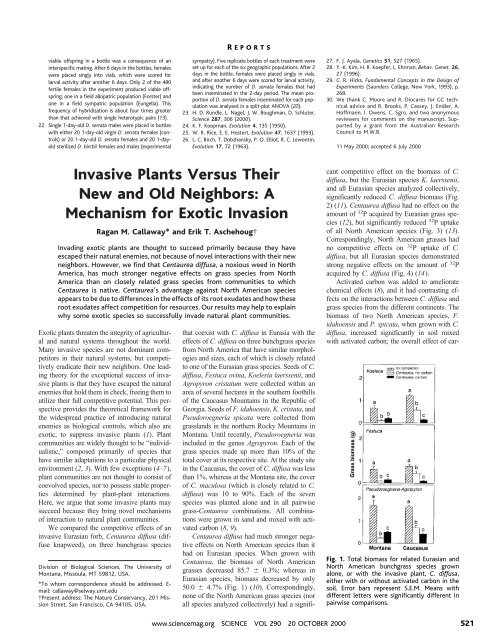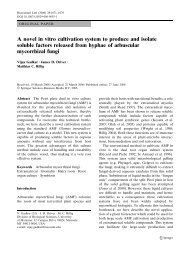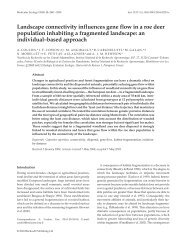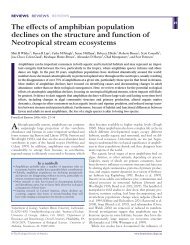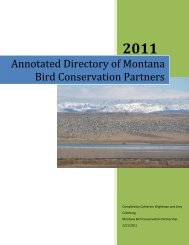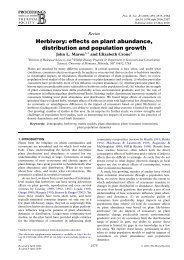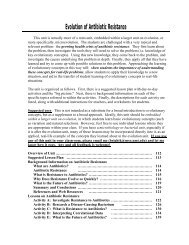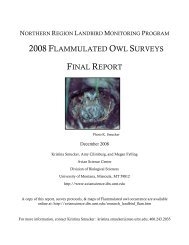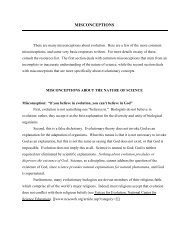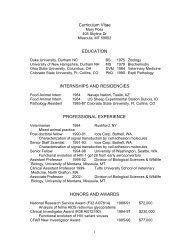Invasive Plants Versus Their New and Old ... - Erik Aschehoug
Invasive Plants Versus Their New and Old ... - Erik Aschehoug
Invasive Plants Versus Their New and Old ... - Erik Aschehoug
Create successful ePaper yourself
Turn your PDF publications into a flip-book with our unique Google optimized e-Paper software.
viable offspring in a bottle was a consequence of an<br />
interspecific mating. After 6 days in the bottles, females<br />
were placed singly into vials, which were scored for<br />
larval activity after another 6 days. Only 2 of the 480<br />
fertile females in the experiment produced viable offspring;<br />
one in a field allopatric population (Forster) <strong>and</strong><br />
one in a field sympatric population (Eungella). This<br />
frequency of hybridization is about four times greater<br />
than that achieved with single heterotypic pairs (13).<br />
22. Single 1-day-old D. serrata males were placed in bottles<br />
with either 20 1-day-old virgin D. serrata females (controls)<br />
or 20 1-day-old D. serrata females <strong>and</strong> 20 1-dayold<br />
sterilized D. birchii females <strong>and</strong> males (experimental<br />
sympatry). Five replicate bottles of each treatment were<br />
set up for each of the six geographic populations. After 2<br />
days in the bottle, females were placed singly in vials,<br />
<strong>and</strong> after another 6 days were scored for larval activity,<br />
indicating the number of D. serrata females that had<br />
been inseminated in the 2-day period. The mean proportion<br />
of D. serrata females inseminated for each population<br />
was analysed in a split-plot ANOVA (20).<br />
23. H. D. Rundle, L. Nagel, J. W. Boughman, D. Schluter,<br />
Science 287, 306 (2000).<br />
24. K. F. Koopman, Evolution 4, 135 (1950).<br />
25. W. R. Rice, E. E. Hostert, Evolution 47, 1637 (1993).<br />
26. L. C. Birch, T. Dobzhansky, P. O. Elliot, R. C. Lewontin,<br />
Evolution 17, 72 (1963).<br />
<strong>Invasive</strong> <strong>Plants</strong> <strong>Versus</strong> <strong>Their</strong><br />
<strong>New</strong> <strong>and</strong> <strong>Old</strong> Neighbors: A<br />
Mechanism for Exotic Invasion<br />
Ragan M. Callaway* <strong>and</strong> <strong>Erik</strong> T. <strong>Aschehoug</strong>†<br />
Invading exotic plants are thought to succeed primarily because they have<br />
escaped their natural enemies, not because of novel interactions with their new<br />
neighbors. However, we find that Centaurea diffusa, a noxious weed in North<br />
America, has much stronger negative effects on grass species from North<br />
America than on closely related grass species from communities to which<br />
Centaurea is native. Centaurea’s advantage against North American species<br />
appears to be due to differences in the effects of its root exudates <strong>and</strong> how these<br />
root exudates affect competition for resources. Our results may help to explain<br />
why some exotic species so successfully invade natural plant communities.<br />
Exotic plants threaten the integrity of agricultural<br />
<strong>and</strong> natural systems throughout the world.<br />
Many invasive species are not dominant competitors<br />
in their natural systems, but competitively<br />
eradicate their new neighbors. One leading<br />
theory for the exceptional success of invasive<br />
plants is that they have escaped the natural<br />
enemies that hold them in check, freeing them to<br />
utilize their full competitive potential. This perspective<br />
provides the theoretical framework for<br />
the widespread practice of introducing natural<br />
enemies as biological controls, which also are<br />
exotic, to suppress invasive plants (1). Plant<br />
communities are widely thought to be “individualistic,”<br />
composed primarily of species that<br />
have similar adaptations to a particular physical<br />
environment (2, 3). With few exceptions (4–7),<br />
plant communities are not thought to consist of<br />
coevolved species, nor to possess stable properties<br />
determined by plant-plant interactions.<br />
Here, we argue that some invasive plants may<br />
succeed because they bring novel mechanisms<br />
of interaction to natural plant communities.<br />
We compared the competitive effects of an<br />
invasive Eurasian forb, Centaurea diffusa (diffuse<br />
knapweed), on three bunchgrass species<br />
Division of Biological Sciences, The University of<br />
Montana, Missoula, MT 59812, USA.<br />
*To whom correspondence should be addressed. Email:<br />
callaway@selway.umt.edu<br />
†Present address: The Nature Conservancy, 201 Mission<br />
Street, San Francisco, CA 94105, USA.<br />
R EPORTS<br />
that coexist with C. diffusa in Eurasia with the<br />
effects of C. diffusa on three bunchgrass species<br />
from North America that have similar morphologies<br />
<strong>and</strong> sizes, each of which is closely related<br />
to one of the Eurasian grass species. Seeds of C.<br />
diffusa, Festuca ovina, Koeleria laerssenii, <strong>and</strong><br />
Agropyron cristatum were collected within an<br />
area of several hectares in the southern foothills<br />
of the Caucasus Mountains in the Republic of<br />
Georgia. Seeds of F. idahoensis, K. cristata, <strong>and</strong><br />
Pseudoroegneria spicata were collected from<br />
grassl<strong>and</strong>s in the northern Rocky Mountains in<br />
Montana. Until recently, Pseudoroegneria was<br />
included in the genus Agropyron. Each of the<br />
grass species made up more than 10% of the<br />
total cover at its respective site. At the study site<br />
in the Caucasus, the cover of C. diffusa was less<br />
than 1%, whereas at the Montana site, the cover<br />
of C. maculosa (which is closely related to C.<br />
diffusa) was 10 to 90%. Each of the seven<br />
species was planted alone <strong>and</strong> in all pairwise<br />
grass-Centaurea combinations. All combinations<br />
were grown in s<strong>and</strong> <strong>and</strong> mixed with activated<br />
carbon (8, 9).<br />
Centaurea diffusa had much stronger negative<br />
effects on North American species than it<br />
had on Eurasian species. When grown with<br />
Centaurea, the biomass of North American<br />
grasses decreased 85.7 0.3%; whereas in<br />
Eurasian species, biomass decreased by only<br />
50.0 4.7% (Fig. 1) (10). Correspondingly,<br />
none of the North American grass species (nor<br />
all species analyzed collectively) had a signifi-<br />
27. F. J. Ayala, Genetics 51, 527 (1965).<br />
28. Y.-K. Kim, H. R. Koepfer, L. Ehrman, Behav. Genet. 26,<br />
27 (1996).<br />
29. C. R. Hicks, Fundamental Concepts in the Design of<br />
Experiments (Saunders College, <strong>New</strong> York, 1993), p.<br />
268.<br />
30. We thank C. Moore <strong>and</strong> R. Diocares for GC technical<br />
advice <strong>and</strong> R. Brooks, P. Cassey, J. Endler, A.<br />
Hoffmann, I. Owens, C. Sgro, <strong>and</strong> two anonymous<br />
reviewers for comments on the manuscript. Supported<br />
by a grant from the Australian Research<br />
Council to M.W.B.<br />
11 May 2000; accepted 6 July 2000<br />
cant competitive effect on the biomass of C.<br />
diffusa, but the Eurasian species K. laerssenii,<br />
<strong>and</strong> all Eurasian species analyzed collectively,<br />
significantly reduced C. diffusa biomass (Fig.<br />
2) (11). Centaurea diffusa had no effect on the<br />
amount of 32 P acquired by Eurasian grass species<br />
(12), but significantly reduced 32 P uptake<br />
of all North American species (Fig. 3) (13).<br />
Correspondingly, North American grasses had<br />
no competitive effects on 32 P uptake of C.<br />
diffusa, but all Eurasian species demonstrated<br />
strong negative effects on the amount of 32 P<br />
acquired by C. diffusa (Fig. 4) (14).<br />
Activated carbon was added to ameliorate<br />
chemical effects (8), <strong>and</strong> it had contrasting effects<br />
on the interactions between C. diffusa <strong>and</strong><br />
grass species from the different continents. The<br />
biomass of two North American species, F.<br />
idahoensis <strong>and</strong> P. spicata, when grown with C.<br />
diffusa, increased significantly in soil mixed<br />
with activated carbon; the overall effect of car-<br />
Fig. 1. Total biomass for related Eurasian <strong>and</strong><br />
North American bunchgrass species grown<br />
alone, or with the invasive plant, C. diffusa,<br />
either with or without activated carbon in the<br />
soil. Error bars represent S.E.M. Means with<br />
different letters were significantly different in<br />
pairwise comparisons.<br />
www.sciencemag.org SCIENCE VOL 290 20 OCTOBER 2000 521
522<br />
bon on North American species in competition<br />
with C. diffusa was positive <strong>and</strong> significant (Fig.<br />
1) (10). In contrast, the biomass of all Eurasian<br />
grass species growing with C. diffusa was reduced<br />
dramatically in the presence of activated<br />
carbon. Correspondingly, activated carbon gave<br />
C. diffusa a competitive disadvantage against<br />
North American grasses (Centaurea biomass<br />
was reduced) but a competitive advantage in the<br />
presence of Eurasian grasses (Centaurea biomass<br />
increased) (Fig. 2) (12). Unlike its effect<br />
on total biomass, the effect of activated carbon<br />
was not to enhance the uptake of 32 P of North<br />
American grasses in the presence of C. diffusa,<br />
indicating that allelopathic effects were manifest<br />
somewhat independently from competition for<br />
this particular resource (Fig. 3) (13). However,<br />
having activated carbon in the soil was a strong<br />
disadvantage for Eurasian grasses competing<br />
for 32 P with C. diffusa. In all cases, 32 P uptake<br />
by Eurasian grasses growing with C. diffusa<br />
decreased in the presence of activated carbon.<br />
The effects of activated carbon on 32 P uptake<br />
by grasses corresponded with the effects of<br />
activated carbon on 32 P uptake by C. diffusa.<br />
Activated carbon enhanced uptake by C. diffusa<br />
in the presence of Eurasian grasses but<br />
reduced uptake in the presence of North<br />
American grasses (Fig. 4) (14). We interpret<br />
the effects of activated carbon as evidence for<br />
allelopathy, as have others (15–17); however,<br />
activated carbon may also affect other soil properties,<br />
as well as the soil microbial community.<br />
In a separate experiment (9), activated carbon<br />
did not have any significant direct effect on<br />
Fig. 2. Total biomass for C. diffusa plants grown<br />
alone, or with Eurasian or North American bunchgrass<br />
species, either with or without activated<br />
carbon in the soil. Error bars represent S.E.M.<br />
Means with different letters were significantly<br />
different in pairwise comparisons.<br />
R EPORTS<br />
the total biomass of any of the six grass species<br />
when they were grown alone, nor was the effect<br />
of carbon significant when all species were<br />
tested together [ANOVA, treatment, F(1,97) <br />
0.53, P 0.471]. As found in the first experiment,<br />
the Eurasian grass species were larger<br />
than North American grass species [region,<br />
F(1,97) 13.11, P 0.001].<br />
When grown with C. diffusa, the proportion<br />
of total pot biomass made up of grasses was<br />
greater for Eurasian (38%) than North American<br />
(11%) species. Concomitantly, proportional biomass<br />
of C. diffusa was less when it was grown<br />
with Eurasian than with North American grasses.<br />
Activated carbon increased the dominance of<br />
C. diffusa with Eurasian grasses (84% from<br />
62%) but decreased its dominance with North<br />
American grasses (78% from 89%). Significant<br />
biogeographical differences also existed for the<br />
total biomass <strong>and</strong> total resource uptake by both<br />
individuals combined within a pot. Pots with<br />
Eurasian grass species combined with C. diffusa<br />
produced 12% more total biomass <strong>and</strong> took up<br />
63% more total phosphorus than pots with<br />
North American species planted with C. diffusa<br />
(18), suggesting that long-term association<br />
among plant species may enhance productivity<br />
<strong>and</strong> total resource utilization.<br />
The strong effects of biogeographical<br />
place of origin on the competitive ability of<br />
grass species against C. diffusa, as well as the<br />
contrasting effects of activated carbon on<br />
Fig. 3. Total counts per minute for related Eurasian<br />
<strong>and</strong> North American bunchgrass species<br />
grown alone, or with the invasive plant, C. diffusa,<br />
either with or without activated carbon in the<br />
soil. Error bars represent S.E.M. Means with different<br />
letters were significantly different in pairwise<br />
comparisons.<br />
20 OCTOBER 2000 VOL 290 SCIENCE www.sciencemag.org<br />
competition, suggest that C. diffusa produces<br />
chemicals to which long-term <strong>and</strong> familiar<br />
Eurasian neighbors have adapted, but to<br />
which C. diffusa’s new North American<br />
neighbors have not. Chemical allelopathy has<br />
long been suspected as a mechanism by<br />
which invasive plant species eliminate natives<br />
(19–21). The competitive ability of Eurasian<br />
grass species against C. diffusa is greatly<br />
reduced by activated carbon, suggesting<br />
that the natural advantage of Eurasian species<br />
is, at least in part, also chemically mediated.<br />
In our experiments, the root systems of competing<br />
plants were constricted in pots, preventing<br />
any spatial root niche partitioning<br />
that might reduce competitive interactions.<br />
Contrasting interactions among plants<br />
from different biogeographical regions have<br />
several implications for community ecology.<br />
First, they suggest that natural plant communities<br />
may be more tightly knit entities than<br />
generally thought. Second, these biogeographical<br />
effects conflict with the theory that<br />
plant competition is not species-specific (22,<br />
23). Third, they suggest that interactions<br />
among plant species may drive natural selection<br />
in communities. Fourth, they imply that<br />
natural biological communities may evolve in<br />
some way as functionally organized units<br />
(24, 25). Finally, our results indicate that<br />
some exotic invasive plants may use competitive<br />
mechanisms that are not present in the<br />
natural communities that they invade to disrupt<br />
inherent, coevolved interactions among<br />
long-associated native species.<br />
Fig. 4. Total counts per minute for C. diffusa<br />
plants grown alone, or with Eurasian or North<br />
American bunchgrass species, either with or without<br />
activated carbon in the soil. Error bars represent<br />
S.E.M. Means with different letters were significantly<br />
different in pairwise comparisons.
References <strong>and</strong> Notes<br />
1. R. G. Van Driesche, T. S. Bellows Jr., Biological Control<br />
(Chapman & Hall, <strong>New</strong> York, 1996), chap. 1.<br />
2. H. A. Gleason, Bull. Torrey Bot. Club 53, 7 (1926).<br />
3. R. M. Callaway, Oecologia 112, 143 (1997).<br />
4. R. Turkington, L. A. Mehrhoff, in Perspectives on Plant<br />
Competition, J. B. Grace, D. Tilman, Eds. (Academic<br />
Press, <strong>New</strong> York, 1990), chap. 15.<br />
5. R. Turkington, J. Ecol. 77, 717 (1989).<br />
6. L. W. Aarssen, R. Turkington, P. B. Cavers, Can. J. Bot.<br />
57, 2695 (1979).<br />
7. L. Menchaca, J. Connolly, J. Ecol. 78, 223 (1990).<br />
8. Each of these seven species was planted alone <strong>and</strong> in all<br />
pairwise grass-Centaurea combinations in pots 20 cm<br />
tall <strong>and</strong> 6 cm in diameter (300 cm 2 volume) with 20<br />
replicates per individual or species combination. The pots<br />
were filled with a 50:50 mixture 20 grit (mean diameter<br />
0.85 mm), <strong>and</strong> 30 grit (mean diameter 0.60 mm) pure<br />
silica s<strong>and</strong> thoroughly mixed with 20 ml of soil from<br />
local Montana grassl<strong>and</strong>s (to introduce microbes) in<br />
which all North American bunchgrasses <strong>and</strong> C. maculosa<br />
(a closely related species to C. diffusa) were present.<br />
Finely ground activated carbon (20 ml, without phosphorus)<br />
per 1 liter of s<strong>and</strong> was added to half of the pots<br />
with solitary grasses <strong>and</strong> with grass-Centaurea combinations.<br />
By mixing activated carbon into the s<strong>and</strong> in half of<br />
the pots, we established an experimental environment in<br />
which the effects of organic root exudates were reduced.<br />
Activated carbon has a high affinity for organic compounds,<br />
such as potentially toxic or “allelopathic” chemicals,<br />
<strong>and</strong> a weak affinity for inorganic electrolytes such<br />
as are found in nutrient solution (26), <strong>and</strong> it has previously<br />
been shown to reduce the negative effects of root<br />
exudates from other species (15–17). Other Centaurea<br />
species have been suspected to be allelopathic, <strong>and</strong> C.<br />
maculosa, which is very similar to C. diffusa, has been<br />
shown to have allelopathic root exudates [W. L. Ridenour,<br />
thesis, University of Montana, Missoula, MT, USA].<br />
A separate experiment was conducted to examine the<br />
direct effects of activated carbon on the grasses. All<br />
plants were grown in a naturally lit growth room <strong>and</strong><br />
supplemented with 12 hours of artificial light at 500<br />
mol m 2 s 1 . Pots were watered approximately every<br />
3 days with distilled water or a dilute nutrient solution.<br />
All plants were started from seed, <strong>and</strong> 3 months after<br />
planting seeds, the roots <strong>and</strong> shoots of all plants were<br />
harvested, dried at 60°C, <strong>and</strong> weighed.<br />
9. We conducted a second experiment designed to test<br />
the direct effects of activated carbon on the total<br />
biomass produced by the six grass species used in the<br />
competition experiment. Each grass species was<br />
planted alone in s<strong>and</strong> with activated carbon <strong>and</strong> in<br />
s<strong>and</strong> without activated carbon (n 7 to 9). Protocol<br />
was as in the competition experiment (26).<br />
10. Analysis of variance was conducted in which the effects<br />
of region, grass genus, <strong>and</strong> carbon treatment were tested.<br />
The dependent variable was the biomass of individual<br />
grasses grown with C. diffusa as a percentage of the<br />
mean biomass for each species when grown alone. Region,<br />
F(1,120) 23.7, P 0.001; grass genus,<br />
F(2,120) 18.22, P 0.001; carbon, F(1,120) 8.35,<br />
P 0.005; region grass genus, F(2,120) 0.21, P <br />
0.813; region carbon, F(1,120) 39.93, P 0.001;<br />
grass genus carbon, F(2,120) 2.06, P 0.132.<br />
11. Analysis of variance was conducted in which the effects<br />
of region (grass origin), grass genus, <strong>and</strong> carbon treatment<br />
were tested. The dependent variable was the biomass<br />
of individual C. diffusa grown with grasses as a<br />
percentage of the mean biomass of C. diffusa when<br />
grown alone. Region, F(1,120) 0.13, P 0.719; grass<br />
genus, F(2,120) 6.45, P 0.002; carbon, F(1,120) <br />
2.30, P 0.133; region grass genus, F(2,120) 0.17,<br />
P 0.841; region carbon, F(1,120) 24.05, P <br />
0.001; grass genus carbon, F(2,120) 2.57, P 0.082.<br />
12. To examine the effects of species <strong>and</strong> the effects of<br />
activated carbon on resource competition, we added<br />
radioactive 32 P to the soil in all treatments 12 days<br />
before harvesting the plants. HCl (5 ml, 0.02 M)<br />
containing 0.1 Ci of 32 P-labeled KH 2 32 PO4 as the<br />
radiation source [after M. M. Caldwell et al., Science<br />
229, 384 (1985)] was injected by using a hypodermic<br />
needle into each pot 10 cm below the surface <strong>and</strong><br />
either halfway between a single plant <strong>and</strong> the pot<br />
edge or halfway between neighbors.<br />
13. Analysis of variance was conducted in which the effects<br />
R EPORTS<br />
of region, grass genus, <strong>and</strong> carbon treatment were tested.<br />
The dependent variable was the total count for 32 Pin<br />
individual grasses grown with C. diffusa as a percentage<br />
of the mean count for each species when grown alone.<br />
Region, F(1,106) 8.46, P 0.005; grass genus,<br />
F(2,106) 0.71, P 0.50; carbon, F(1,106) 59.44, P <br />
0.001; region grass genus, F(2,106) 2.87, P 0.062;<br />
region carbon, F(1,106) 69.16, P 0.001; grass<br />
genus carbon, F(2,106) 1.45, P 0.239.<br />
14. Analysis of variance was conducted in which the<br />
effects of region (grass origin), grass genus, <strong>and</strong> carbon<br />
treatment were tested. The dependent variable<br />
was the total count for 32 P of individual C. diffusa<br />
grown with grasses as a percentage of the mean<br />
biomass of C. diffusa when grown alone. Region,<br />
F(1,98) 0.01, P 0.939; grass genus, F(2,98) <br />
0.18, P 0.834; carbon, F(1,98) 1.75, P 0.190;<br />
region grass genus, F(2,98) 0.81, P 0.449;<br />
region carbon, F(1,98) 18.18, P 0.001; grass<br />
genus carbon, F(2,98) 1.90, P 0.156.<br />
15. B. E. Mahall, R. M. Callaway, Proc. Natl. Acad. Sci.<br />
U.S.A. 88, 874 (1991).<br />
16. B. E. Mahall, R. M. Callaway, Ecology 73, 2145 (1992).<br />
17. O. Schreiner, H. S. Reed, Bot. Gaz. (February), 73<br />
(1908).<br />
18. Analysis of variance testing for the effects of region<br />
(origin of grasses), grass genus, <strong>and</strong> carbon treatment on<br />
total biomass produced in pots with grasses <strong>and</strong> C.<br />
diffusa together. Region, F(1,120) 4.71, P 0.032;<br />
grass genus, F(1,120) 0.51, P 0.611; carbon,<br />
F(1,120) 0.29, P 0.589; no interactions were significant<br />
(all P 0.30).<br />
19. D. A. Steenhagen, R. I. Zimdahl, Weed Sci. 27, 1<br />
(1979).<br />
20. N. H. Fischer, L. Quijano, in The Chemistry of Allelopathy:<br />
Biochemical Interactions Among <strong>Plants</strong>, A.C.<br />
Thompson, Ed. (American Chemical Society, Washington,<br />
DC, 1985).<br />
21. C. Tang et al., in Allelopathy: Organisms, Processes,<br />
<strong>and</strong> Applications, Inderjit, K. M. M. Dakshini, F. A.<br />
Einhellig, Eds. (American Chemical Society, Washington,<br />
DC, 1995).<br />
22. D. E. Goldberg, P. A. Werner, Am. J. Bot. 70, 1098<br />
(1983).<br />
23. F. S. Chapin III, Ecology 66, 564 (1985).<br />
24. D. S. Wilson, Ecology 78, 2018 (1997).<br />
25. C. J. Goodnight, Evolution 44, 1625 (1990).<br />
26. P. N. Cheremisinoff, F. Ellerbusch, Carbon Adsorption<br />
H<strong>and</strong>book (Ann Arbor Science Publishers, Ann Arbor,<br />
MI, 1978).<br />
27. We thank D. Kikodze <strong>and</strong> Z. Kikvidze for their hospitality<br />
in the Republic of Georgia, help in finding elusive C.<br />
diffusa in Georgia, <strong>and</strong> the collection of seeds. We thank<br />
W. Hill for assistance with the isotope analysis. We<br />
gratefully acknowledge support from the National Science<br />
Foundation, DEB-9726829, <strong>and</strong> from the Andrew<br />
W. Mellon Foundation.<br />
31 July 2000; accepted 21 August 2000<br />
Two–Amino Acid Molecular Switch<br />
in an Epithelial Morphogen That<br />
Regulates Binding to Two Distinct<br />
Receptors<br />
Minhong Yan, 1 * Li-Chong Wang, 1 * Sarah G. Hymowitz, 2<br />
Sarah Schilbach, 3 James Lee, 3 Audrey Goddard, 3<br />
Abraham M. de Vos, 2 Wei-Qiang Gao, 1 Vishva M. Dixit 1 †<br />
Ectodysplasin, a member of the tumor necrosis factor family, is encoded by the<br />
anhidrotic ectodermal dysplasia (EDA) gene. Mutations in EDA give rise to a<br />
clinical syndrome characterized by loss of hair, sweat gl<strong>and</strong>s, <strong>and</strong> teeth. EDA-A1<br />
<strong>and</strong> EDA-A2 are two isoforms of ectodysplasin that differ only by an insertion<br />
of two amino acids. This insertion functions to determine receptor binding<br />
specificity, such that EDA-A1 binds only the receptor EDAR, whereas EDA-A2<br />
binds only the related, but distinct, X-linked ectodysplasin-A2 receptor<br />
(XEDAR). In situ binding <strong>and</strong> organ culture studies indicate that EDA-A1 <strong>and</strong><br />
EDA-A2 are differentially expressed <strong>and</strong> play a role in epidermal morphogenesis.<br />
Members of the tumor necrosis factor receptor<br />
(TNFR) superfamily are involved in a<br />
number of physiological <strong>and</strong> pathological responses<br />
by activating a wide variety of intracellular<br />
signaling pathways. In a database<br />
search based on sequence similarity (1),<br />
XEDAR was initially identified as a member<br />
of the TNFR superfamily.<br />
1 2 Department of Molecular Oncology, Department of<br />
Protein Engineering, 3Department of Molecular Biology,<br />
Genentech, 1 DNA Way, South San Francisco, CA<br />
94080, USA.<br />
*These authors contributed equally to this work.<br />
†To whom correspondence should be addressed. Email:<br />
dixit@gene.com<br />
The deduced amino acid sequence of<br />
XEDAR contains three cysteine-rich repeats<br />
<strong>and</strong> a single transmembrane region (Fig. 1A).<br />
XEDAR lacks an NH 2 -terminal signal peptide.<br />
The presence of an in-frame upstream stop<br />
codon in both human <strong>and</strong> mouse cDNA clones<br />
indicated that the sequence shown in Fig. 1A<br />
represents the full-length open reading frame<br />
(ORF) (1). To confirm that XEDAR was indeed<br />
a membrane protein, we transfected<br />
MCF7 cells with either an NH 2 - or COOHterminal<br />
Flag-tagged version of XEDAR (Fig.<br />
1B). In permeabilized cells, the expression of<br />
both tagged proteins was readily detected by<br />
anti-Flag immunostaining. However, in the absence<br />
of permeabilization, cell surface staining<br />
www.sciencemag.org SCIENCE VOL 290 20 OCTOBER 2000 523


